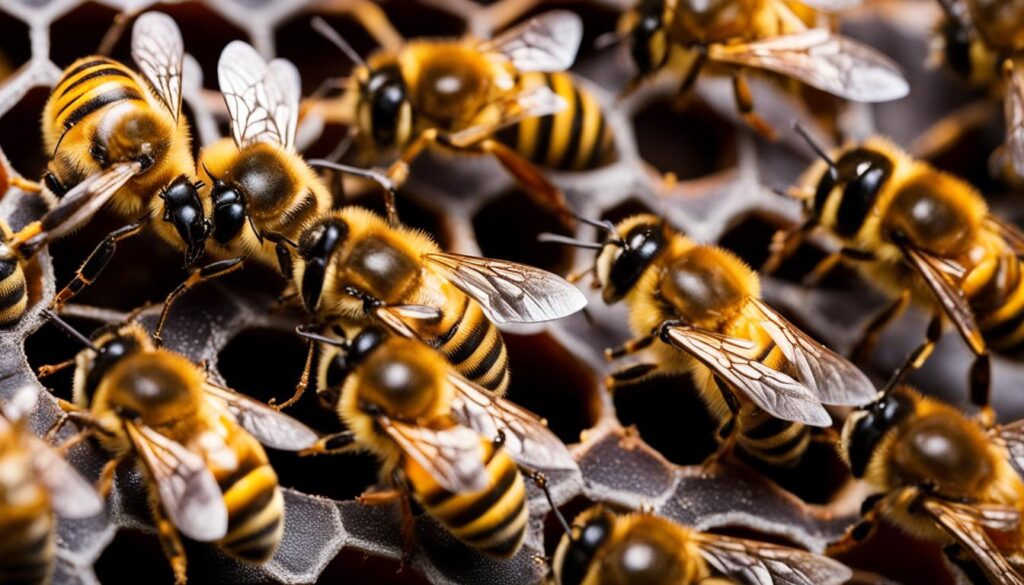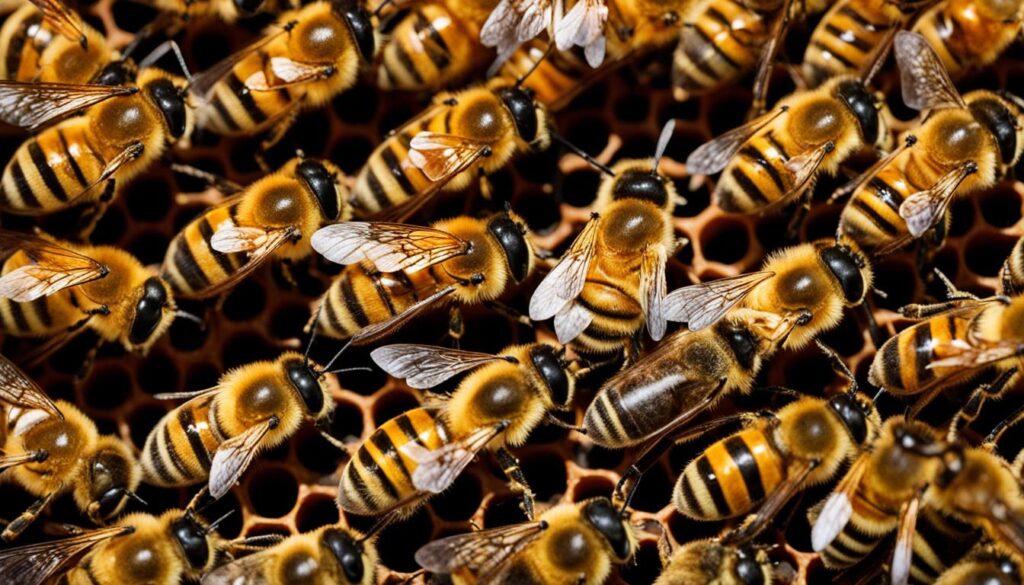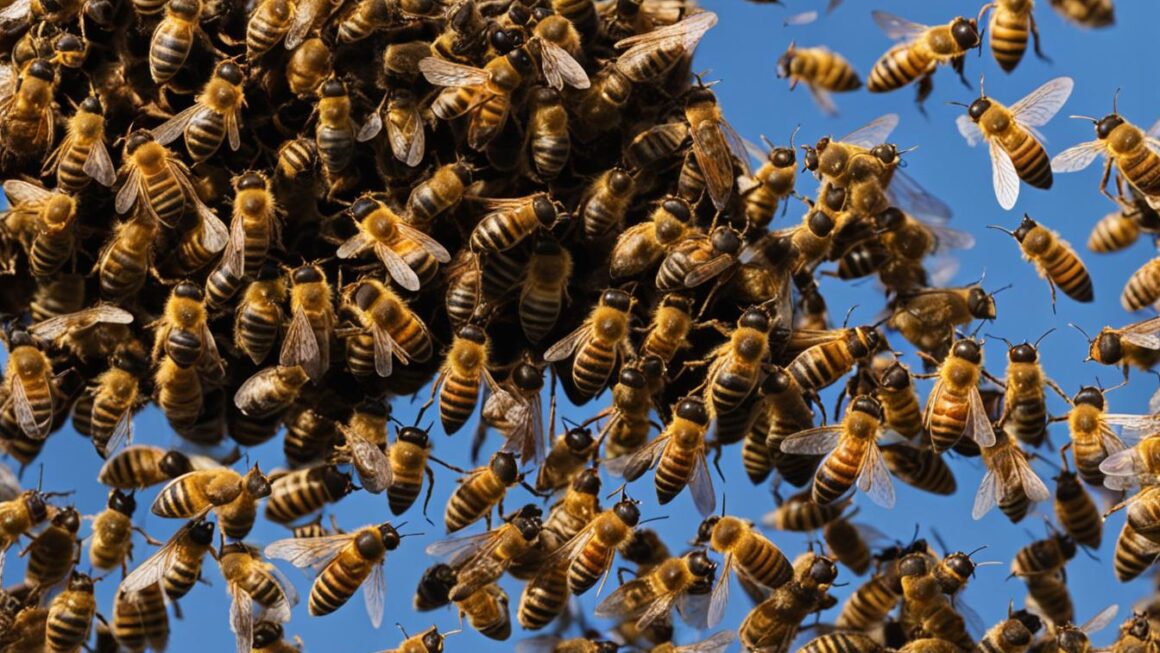A mated queen bee is a crucial component of a successful beekeeping operation. As the primary individual in the colony, the queen’s main role is to lay eggs, ensuring a constant supply of new bees. Without a mated queen bee, the colony’s population will decline, making it vulnerable to pests and ultimately leading to its demise.
Key Takeaways:
- A mated queen bee is essential for maintaining a healthy honey bee colony.
- The queen’s role is to lay eggs and ensure a constant supply of new bees.
- A colony without a mated queen bee is susceptible to pests and population decline.
- Acquiring a mated queen bee can be done through local suppliers or online purchases.
- Consider factors such as genetics and suitability for the beekeeping environment when buying a queen bee.
Importance of a Mated Queen Bee
The mated queen bee plays a vital role in maintaining the colony’s population by continuously laying eggs. This ensures the presence of new workers to replace the bees that die daily. Without a mated queen bee, the colony’s population will decline, making it susceptible to infestations by pests such as wax moths or hive beetles, which can take over the hive and cause its collapse.
“The presence of a mated queen bee is crucial for the success of a beekeeping operation,” says John Smith, a seasoned beekeeper with over 20 years of experience.
“The queen bee is responsible for the reproduction and sustainability of the colony. Without her consistent egg-laying, the population diminishes, making the colony vulnerable to pest infestations and ultimately leading to its demise.”
Importance of a Mated Queen Bee
| Benefit | Description |
|---|---|
| Colony Population | A mated queen bee ensures a constant supply of new bees by continuously laying eggs, maintaining the colony’s population. |
| New Bees | The presence of new workers is essential to replace the bees that die daily and ensure the colony’s productivity. |
| Pest Resistance | A healthy and thriving population is better equipped to defend against infestations by pests such as wax moths and hive beetles. |
Where to Find a Mated Queen Bee
Acquiring a mated queen bee is a crucial step in beekeeping, and there are several options available to beekeepers. Local bee supply stores are a great place to start, as they often have extra queens for sale. These stores typically stock a variety of queen bees, allowing beekeepers to choose the best option for their specific needs. Additionally, reputable beekeepers in the local community may also raise and sell surplus queens, providing another avenue for acquiring a mated queen bee.
For those who prefer the convenience of online shopping, purchasing a queen bee from an online supplier is also an option. Many websites specialize in selling queen bees and beekeeping supplies, offering a wide range of choices. However, it is important to research the reputation of the seller before making a purchase. Reading customer reviews and checking for any available guarantees regarding live delivery can help ensure a positive buying experience.
When purchasing a mated queen bee, it is essential to consider factors such as the season, the reputation of the supplier, and any specific requirements for the beekeeping operation. Beekeepers should determine the type of queen bee they need, whether it is a specific breed or one with desired traits such as disease resistance or honey production. Taking the time to choose the right mated queen bee can contribute to the success and productivity of the colony.
| Pros of Buying a Mated Queen Bee | Cons of Buying a Mated Queen Bee |
|---|---|
| Allows for introduction of new genetics | Cost of purchasing a queen bee |
| Ensures a mated and productive queen | Potential for delays or issues in delivery |
| Convenient option for beekeepers with limited access to local suppliers | Possible differences in temperament or behavior compared to the existing colony |
Overall, acquiring a mated queen bee is an important aspect of successful beekeeping. Whether through local suppliers, online purchases, or other beekeepers in the community, beekeepers have several options for finding a mated queen bee. Careful consideration of factors such as genetics, reputation, and specific needs will contribute to the health and productivity of the colony.
Factors to Consider When Buying a Mated Queen Bee
When purchasing a mated queen bee, there are several important factors to take into consideration. These factors can greatly impact the success of your beekeeping operation and the overall health of your colony. It is crucial to choose a queen bee that is well-suited to your specific needs and the conditions of your beekeeping environment.
Genetics and Breeding Program
The genetics of a mated queen bee play a significant role in determining the traits and characteristics of the resulting colony. Some breeders specialize in developing bee lines with specific traits, such as varroa resistance, high honey production, or suitability for colder climates. Consider the goals you have for your apiary and select a queen bee that aligns with those objectives.
Cost and Availability
The cost of a mated queen bee can vary depending on various factors, including the location and breeding program. Breeder queens that are artificially inseminated are typically more expensive than naturally mated queens. Consider your budget and the availability of queen bees in your area when making your purchasing decision.
Health and Quality
It is essential to choose a mated queen bee that is healthy and of high quality. Look for a supplier with a good reputation and inquire about any guarantees or warranties they offer regarding live delivery and the health of the queen bee. A healthy queen bee will have a higher chance of successfully establishing a thriving colony.
| Factors to Consider | Importance |
|---|---|
| Genetics and Breeding Program | High |
| Cost and Availability | Medium |
| Health and Quality | High |
By carefully considering these factors when buying a mated queen bee, you can increase the likelihood of a successful beekeeping experience and a thriving colony. Remember to choose a queen bee that aligns with your goals, fits within your budget, and is healthy and of high quality.
Care Before Installing a Mated Queen Bee
Proper care before installing a mated queen bee is essential to ensure a smooth transition and the well-being of both the queen and the colony. When the queen arrives, she will typically be in a small cage made of either wood and wire or plastic. It is crucial to keep the queen cage safe in a cool and dark place until installation. This will help maintain the queen’s health and prevent any unnecessary stress.
It is recommended to install the mated queen bee as soon as possible after her arrival. This allows her to start laying eggs and establishing herself as the leader of the colony. While some beekeepers may use special queen introduction frames, it is not a requirement for successfully installing a mated queen bee. The queen cage can be secured to a comb using rubber bands or wire, ensuring that the worker bees have access to the queen without being able to harm her.
Remember that bees are sensitive to temperature and environment changes, so it is important to handle the queen and her cage with care. Avoid exposing her to extreme temperatures or direct sunlight. By providing the necessary care and attention, you can increase the chances of a successful introduction and give your colony the best opportunity to thrive under the leadership of a mated queen bee.
| Important Care Tips Before Installing a Mated Queen Bee |
|---|
| Keep the queen cage in a cool and dark place until installation. |
| Install the mated queen bee as soon as possible after her arrival. |
| Secure the queen cage to a comb using rubber bands or wire. |
| Avoid exposing the queen to extreme temperatures or direct sunlight. |
“Proper care and attention before installing a mated queen bee can greatly increase the chances of a successful introduction and a thriving colony.” – Beekeeping expert
What to Do If the Queen Bee Dies in the Cage
In the unfortunate event that the mated queen bee dies while in the cage, it is important to take immediate action. Contact the supplier right away and inform them about the situation. It is crucial to inquire about any live arrival guarantees or policies the supplier may have before ordering queens through the mail. This will help you understand what options are available to you in case of any unfortunate incidents.
Should the queen bee die in the cage, the supplier may offer a replacement queen bee. However, it is important to note that this is subject to their policies and availability. Some suppliers may require you to file a claim with the postal service in order to obtain a refund for the deceased queen bee.
When dealing with the loss of a mated queen bee, it is essential to act swiftly and communicate with the supplier to resolve the issue. This will ensure the continuity and success of your beekeeping endeavors.

| Steps to Take If the Queen Bee Dies in the Cage |
|---|
| Contact the supplier immediately |
| Inquire about live arrival guarantees or policies |
| Seek a replacement queen bee if available |
| File a claim with the postal service for a refund if necessary |
Reasons for Buying a Mated Queen Bee
Beekeepers have several reasons for choosing to buy a mated queen bee instead of relying on natural queen reproduction within their colonies. One significant reason is the desire to introduce new genetics into their apiary. Bee breeders often focus on developing bee lines with specific characteristics suited for different climates or desired traits such as calm temperament or high honey production. By purchasing a mated queen bee from a reputable breeder, beekeepers can access these desired traits and enhance the productivity of their colonies.
Another reason for buying a mated queen bee is the need for colony reproduction. In some cases, a colony may be unable to produce a queen itself due to factors such as a lack of fresh eggs or failed attempts at requeening. By introducing a mated queen bee into the colony, beekeepers can ensure the continuity of the bee population and maintain the colony’s productivity and resilience.
Furthermore, buying a mated queen bee allows beekeepers to save time and effort. Rearing a queen bee from scratch requires considerable resources, including a well-established and healthy colony, the right environmental conditions, and the expertise to manage the complex process. By purchasing a mated queen bee, beekeepers can skip the time-consuming and uncertain process of queen rearing and focus on other aspects of beekeeping, such as honey production or colony management.
Overall, buying a mated queen bee provides beekeepers with access to desirable genetic traits, ensures colony reproduction, and saves time and effort. It is a practical and efficient way to support the health and productivity of bee colonies while benefiting from the expertise of experienced bee breeders.
Mated Queen Bee: Queen Rearing and the Development Process
Queen development and rearing is a fascinating and essential aspect of beekeeping. Queens are raised from fertilized eggs, and the diet provided to the larvae determines whether they become queens or workers. Throughout the process, honey bee colonies construct queen cells and raise queens in response to various factors such as queenlessness, swarming, or supersedure. Understanding queen development and mastering queen rearing techniques can greatly enhance colony productivity and increase self-sufficiency in beekeeping.
During queen development, selected larvae are fed a special substance called royal jelly, which triggers their development into queens. The larvae are then sealed inside queen cells, where they undergo pupation and metamorphosis. This process typically takes around 16 days, after which the fully developed queens emerge from their cells.
Queen rearing is a meticulous process that involves careful selection of breeder queens and the creation of queen cells through artificial or natural methods. Artificial methods, such as grafting or the use of queen rearing kits, allow beekeepers to have precise control over the queen rearing process. Natural methods, such as allowing the bees to raise queens on their own, can be more time-consuming but may be preferred by beekeepers who prioritize maintaining the colony’s natural instincts.
Table: Queen Rearing Techniques
| Technique | Description |
|---|---|
| Grafting | The process of transferring selected larvae into artificial queen cups for rearing. |
| Cell Punching | Removing capped brood cells from a strong colony and transferring them to a queenless colony for queen rearing. |
| Natural Queen Rearing | Allowing the bees to raise queens on their own by providing them with the necessary conditions and resources. |
Successful queen rearing requires precise timing, proper nutrition, and a conducive environment. It is crucial to ensure the health and quality of the breeder queens, as their genetics play a significant role in determining the traits and productivity of the resulting queens. Beekeepers who engage in queen rearing can potentially improve their colonies by selecting for desired characteristics such as disease resistance, honey production, or calm temperament.
By gaining knowledge and expertise in queen rearing, beekeepers can not only maintain a consistent supply of mated queen bees but also contribute to the overall health and resilience of their colonies. Queen rearing is a valuable skill within the beekeeping industry and empowers beekeepers to actively manage and improve their apiaries.

Conclusion
The presence of a mated queen bee is essential for successful beekeeping. A mated queen bee ensures the continuous production of new bees, maintaining the colony’s population and vitality. Without a mated queen bee, the colony is at risk of decline and vulnerability to pests, which can lead to its demise.
Acquiring a mated queen bee is relatively easy, with options such as local bee supply stores, reputable beekeepers, and online purchases. When purchasing a queen bee, it is important to consider factors such as cost, suitability for specific needs, and the reputation of the seller.
Before installing a mated queen bee, proper care should be taken, including keeping the queen cage in a cool and dark place until installation. In the unfortunate event that the queen bee dies in the cage, it is crucial to contact the supplier immediately to inquire about replacements or refunds.
Understanding queen rearing and the development process is valuable for beekeepers. By enhancing their knowledge in these areas, beekeepers can optimize colony productivity and increase their self-sufficiency in successful beekeeping practices.
FAQ
Why is a mated queen bee important for a beekeeping operation?
A mated queen bee is crucial for a beekeeping operation as she lays eggs, ensuring a constant supply of new bees and maintaining the colony’s population.
Where can I find a mated queen bee?
You can find a mated queen bee at local bee supply stores, reputable beekeepers, or through online purchases.
What factors should I consider when buying a mated queen bee?
Factors to consider include cost, suitability for your specific needs, and the reputation and guarantees provided by the seller.
How should I care for the mated queen bee before installing her?
The queen bee should be kept safe in a cool and dark place until installation. Special care should be taken to ensure her well-being and the colony’s success.
What should I do if the queen bee dies in the cage?
In the unfortunate event of the queen bee’s death, it is important to contact the supplier immediately and inquire about live arrival guarantees and potential replacements or refunds.
Why would I buy a mated queen bee?
Beekeepers may buy a mated queen bee to introduce new genetics, improve colony traits, or when a colony is unable to produce a queen on its own.
What is the process of queen rearing and development?
Queen bees are raised from fertilized eggs, and various factors can trigger the construction of queen cells and the rearing of new queens by honey bee colonies.




